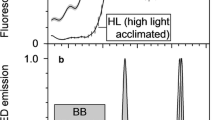Abstract
After preheating of Amaranthus chloroplasts at elevated temperatures (up to 45°C), the chlorophyll a fluorescence level under low excitation light rises as compared to control (unheated) as observed earlier in other chloroplasts (Schreiber U and Armond PA (1978) Biochim Biophys Acta 502: 138–151). This elevation of heat induced fluorescence yield is quenched by addition of 0.1 mM potassium ferricyanide, suggesting that with mild heat stress the primary electron acceptor of photosystem II is more easily reduced than the unheated samples. Furthermore, the level of fluorescence attained after illumination of dithionite-treated samples is independent of preheating (up to 45°C). Thus, these experiments indicate that the heat induced rise of fluorescence level at low light can not be due to changes in the elevation in the true constant F0 level, that must by definition, be independent of the concentration of QA. It is supposed that the increase in the fluorescence level by weak modulated light is either partly associated with dark reduction of QA due to exposure of chloroplasts to elevated temperature or due to temperature induced fluorescence rise in the so called inactive photosystem II centre where QA are not connected to plastoquinone pool. In the presence of dichlorophenyldimethylurea the fluorescence level triggered by weak modulated light increases at alkaline pH, both in control and heat stressed chloroplasts. This result suggests that the alkaline pH accelerates electron donation from secondary electron donor of photosystem II to QA both in control and heat stressed samples. Thus the increase in fluorescence level probed by weak modulated light due to preheating is not solely linked to increase in true F0 level, but largely associated with the shift in the redox state of QA, the primary stable electron acceptor of photosystem II.
Similar content being viewed by others
Abbreviations
- ADRY:
-
Acceleration of Deactivation of Reaction of Enzyme Y
- CCCP:
-
Carbonyl cyanide 4-(trifluoromethoxy)-phenylhydrazone
- Chl:
-
Chlorophyll
- DCMU:
-
3-(3,4-dichlorophenyl)-1,1-dimethylurea
- FeCN:
-
potassium ferricyanide
- HEPES:
-
4-(2-hydroxy ethyl)-1-piperazine ethane sulfonic acid
- LHCP:
-
Light harvesting chlorophyll protein
- MES:
-
(4-morpholine ethane sulfonic acid)
- PS:
-
photosystem
- QA and QB :
-
first and second consecutive electron acceptors of photosystem II
- TES:
-
(2-[tris(hydroxymethyl)-methylamino]-1-ethanesulfonic acid) sulfonic acid
- TRICINE:
-
N-[tris(hydroxymethyl)methyl] glycine
References
Berry J and Björkman O (1980) Photosynthetic response and adaptation to temperature in higher plants. Annu Rev Plant Physiol 31: 491–543
Bukhov NG, Damimov HG, Dzhibladge TG, Riznicheudo G Yu, Karapetyan NV and Rubin AB (1988) Kinetic analysis of electron transfer within photosystem II in the presence of Diuron and CCCP. Biol Sciences (USSR) pp 28–37 ISSN 0470–4606
Cramer WA and Butler WL (1969) Potentiometric titration of the fluorescence yield and spinach chloroplasts. Biochim Biophys Acta 172: 503–510
Downton WJS and Berry JA (1982) Chlorophyll fluorescence at high temperature. Biochim Biophys Acta 679: 474–478
Ducruet JM and Lemoine Y (1985) Increased heat sensitivity of the photosynthetic apparataus in triazine-resistant biotypes from different plant species. Plant Cell Physiol 26: 419–429
Duysens LNM and Sweers HE (1963) Mechanism of two photochemical reactions in algae as studied by means of fluorescence. In: Studies of Microalgae and Photosynthetic Bacteria. Special Issue of Plant Cell Physiology. Japan Society of Plant Physiology, University of Tokyo Press, Tokyo, pp 353–372
Fork DC, Mohanty P and Hoshina S (1985) The detection of early events in heat disruption in thylakoid membranes by delayed light emission. Physiol Veg 23: 511–521
Havaux M and Lannoye R (1985) In vivo chlorophyll fluorescence and delayed light emission as rapid screening techniques for stress tolerance in Crop Plants. Z. pflanzenzucht B 95 No. 1, p. 1–18
Karapetyan NV and Bukhov NG (1986) Variable fluorescence as on indicator of physiological state of plants. Fiziologia rastenii (USSR) 34: 1013–1026.
Klimov VV and Krasnovskii AA (1981) Pheophytin as a primary electron acceptor in photosystem II reaction centre. Photosynthetica 15(4): 592–609
Krause GH, Briantais J-M and Vernotte C (1983) Characterization of chlorophyll fluorescence quenching in chloroplasts by fluorescence spectroscopy at 77K. I. ΔpH dependent quenching. Biochim Biophys Acta 723: 169–175
Krause GH and Weis E (1984) Chlorophyll fluorescence as a tool in plant physiology II. Interpretation of fluorescence signals. Photosynthesis Res 5: 139–157
Papageorgiou G (1975) Chlorophyll fluoresence: An intrinsic probe of photosynthesis In: Govindjee (ed) Bioenergetics of Photosynthesis Academic Press, New York, pp 319–369
Quick WP and Horton P (1984) Studies on the induction of chlorophyll fluorescence in barley protoplasts. II, Resolution of fluorescence quenching by redox state and the transthylakoid pH gradient. Proc R Soc Lond B 220: 371–382
Sabat SC, Mohanty N and Mohanty P (1986) Heat-induced alteration in electron donation site(s) of ascorbate and ascorbate-reduced catechol in the electron transport chain of Amaranthus chloroplasts. Ind J Biochem Biophys 23: 266–269
Schreiber U and Berry JA (1977) Heat-induced changes of chlorophyll fluorescence in intact leaves correlated with damage of the photosynthetic apparatus. Planta 136: 233–238
Schreiber U and Armond PA (1978) Heat-induced changes of chlorophyll fluorescence in isolated chloroplasts and related heat-damage at the pigment level. Biochim Biophys Acta 502: 138–151
Schreiber U, Schliwa U and Bilger W (1986) Continuous recording of photochemical and non-photochemical chlorophyll fluorescence quenching with a new type of modulation fluorometer. Photosynthesis Res 10: 51–62
Author information
Authors and Affiliations
Rights and permissions
About this article
Cite this article
Bukhov, N.G., Sabat, S.C. & Mohanty, P. Analysis of chlorophyll a fluoresence changes in weak light in heat treated Amaranthus chloroplasts. Photosynth Res 23, 81–87 (1990). https://doi.org/10.1007/BF00030066
Received:
Accepted:
Issue Date:
DOI: https://doi.org/10.1007/BF00030066




